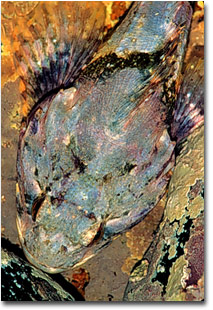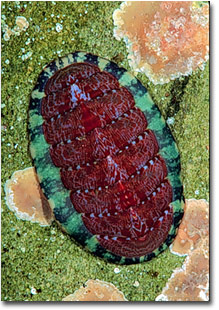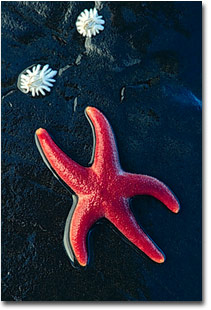Tide Pools - Windows On The Ocean
Text and photography copyright Gustav W. Verderber. All rights reserved.
On the western shore of the Schootic Peninsula of Acadia National Park, on a chilly June morning, I emerge from a gallery of haggard black spruce and step onto the intertidal, that opulent strip of amphibious beach between the tidemarks. Lobster boats in Winter Harbor float like pastel apparitions in the fog-shrouded bay. A somnolent sea barely stirs; the only sounds are the intermittent bellowing of the foghorn and the cadence made by the gentlest waves licking the rockweed like a cat grooming its kitten.
After splaying my Gitzo tripod on the red, African granite (congealed to the North American plate when Africa and North America were once part of the super continent Pangea), I draw the redolent sea air into my lungs and savor the heady
 vapors of brine, seaside rose, desiccating snails, algae, starfish, and mussels, and the rotting debris of marine life that packs every divot, nook, and crevice on this fractured, bolder-strewn beach like caulking. Then I slip my Lowe Pro Trekker off of my back and begin walking slowly, attentively, across the intertidal.
vapors of brine, seaside rose, desiccating snails, algae, starfish, and mussels, and the rotting debris of marine life that packs every divot, nook, and crevice on this fractured, bolder-strewn beach like caulking. Then I slip my Lowe Pro Trekker off of my back and begin walking slowly, attentively, across the intertidal.
I’ve never taken a poll, but I’ll bet a brick of Velvia that I am the only Vermonter who keeps an annual tide table in the glove compartment of his Ford Ranger. A full moon shone the night before and today the tidal amplitude – the maximum distance between high and low tide - is at its monthly peak. Put another way, the lowest low tide and the highest high tide, known as the spring tides, occur on this day. Whatever influences a full moon may exert on us, I know that its power over me is to draw me to the edge of the sea. Today the low tide will reveal wonders that normally could only be glimpsed by diving or snorkeling in the 53o F water.
We nature photographers will travel hundreds of miles to admire and photograph a northern hawk owl sojourning in New England and, of course, we’ll all strive to take that requisite African safari even if it means liquidating a substantial part of our 401K plans. (Oh, that’s right, we don’t have those; never mind.) Yet, I still get dubious stares from some peers when I tell them that I drive seven hours to the Maine coast from my home in northern Vermont just to spend two or three days poking around the intertidal. When I explain that ninety percent of all of the Earth’s marine life inhabits coastal environments, and that coastal ecosystems, including estuaries, rocky shores, mangrove and kelp forests, not to mention coral reefs rank among the most productive (read biologically rich) ecosystems on the planet, right up there with tropical rainforests, their skepticism turns to fascination.
Add to that the “edge effect”. Wherever two or more wildlife communities, say a pond and a meadow meet, the margin or edge between the adjoining communities is visited by species from both communities. Thus, the species diversity of the edge becomes enriched and you get a marsh in which bluegills as well as red-winged black birds seek common refuge among the cattails. Additionally, you also get “fringe species” that are uniquely suited for living in the transition zone between ecosystems. The cattails, for example, would perish if they became entirely submerged, i.e., wholly part of the pond community or, equally, planted in the middle of the meadow.
Clearly, the world’s intertidal areas are the ultimate edge ecosystems and the fuzziest of all fringe environments, hence their appeal. Not only does the intertidal host an enormous number of species, including representatives of every major phylum, the organisms that live between the tide marks rank among some of the most bizarre and exotic critters anywhere! On the intertidal, you are likely to encounter almost any kind of animal, from jellyfish to stranded whales, from sea squirts, lugworms, sponges, horseshoe crabs, sea cucumbers, and urchins to seals, nesting sea turtles, eagles feeding on starfish, and even grizzlies digging in the mudflats for clams.
Finally, when you consider the fact that the limiting factor in the intertidal is space (not food), especially in tide pools, you get critters stacked on critters. If you don’t like what’s in the first tide pool you encounter, you have dozens of other tide
 pools to choose from, all of them within sight of or a casual stroll of where you parked your camera bag. Often I can find more wildlife subjects within a single tide pool than I might encounter on a walk through my ten-acres of Northern Forest in the Green Mountains.
pools to choose from, all of them within sight of or a casual stroll of where you parked your camera bag. Often I can find more wildlife subjects within a single tide pool than I might encounter on a walk through my ten-acres of Northern Forest in the Green Mountains.
No description, no amount of ecological erudition can rival actually peering into a tide pool. These are windows on the ocean, portholes to seventy percent of Earth’s living realm. Want to hook a child on Nature? Show it a tide pool.
Coasts with semidiurnal (twice daily) tides, which include most coasts, experience two low tides and two high tides every 24 hours. When the moon and sun are on opposite sides of the Earth, i.e., when the moon is full, low tide occurs at both ends of the day. This allows for two daytime opportunities to photograph the marine life left stranded by the receding sea or trapped inside a tide pool.
A broad shelf of granite pockmarked with assorted tide pools stretches before me. Several are as big around as a wading pool but most average a foot or two in diameter. Strolling among them, I peer into each kaleidoscopic pool, overwhelmed by that delicious feeling that there is no place on Earth I would rather be. Each low tide is like an Easter egg hunt; I never know what new presents the ocean has left for me to find.
Common New England tide pool inhabitants include varied algae (Ascophyllum, Fucus, Ulva, Chondrus species), boreal starfish (Asterias vulgaris), three species of periwinkles (Littorina sp.), tortoiseshell limpets (Acmaea testudinalis), the rock and green crabs (Cancer irroratus & Carcinus maenus), green urchins (Strongylocentrotus droebachiensis), blue mussels (Mytilus edulis), horse mussels (Modiolus modiolus), dog whelks (Thais lapillus), and lots of acorn barnacles (Balanus balanoides). Among the smaller, photographically challenging subjects are the hydroids (Obelia et al.), springtails (Anurida maritime), and, most abundant of all, the plankton (microscopic plants, animals, larvae, protozoans, etc.).
Still, these are all organisms that, for the most part, I could find on any average or neap tide, that is, the tides that prevail during quarter moon. On a spring low tide, however, I am particularly keen to find those species that ordinarily do not become stranded or that inhabit the lower reaches of the intertidal where they are rarely exposed at low tide.
Photographing tide pool organisms in situ is relatively easy once one recalls one of the principles of basic physics, notably, the index of refraction (IR) of water. Simply put, whenever light passes from one medium into another, denser medium, such as from air into water (which is 800 times denser than air), it slows down slightly. The denser medium exerts “drag” on the beam of light, which if the light enters that medium at an oblique angle, is disproportional on either side of the light beam. Consequently, the light beam bends. The greater the angle of incidence, the more the light bends.
What this means to us nature photographers is that any light (natural or artificial) entering a tide pool will be bent away from the intended subject under the water with the result being that less light reaches the subject than would if the subject were in the same medium as the light source. When the light is directly above the tide pool, the loss of light is only about 2%, at 45o you lose 5%, until, at grazing; the loss of light is 100%. The depth of the water between the light source and the subject also influences the exposure.
I learned this the hard way, no, not by taking a refresher course in physics, but by metering the light falling on a starfish I wanted to photograph with an incident light meter held directly above the tide pool. I failed to account for the difference in the amount of sunlight falling on my light meter and the actual illumination on the starfish lying several inches beneath the surface of the pool. All of my images came back underexposed by more than a full stop.
In ambient light, short of sticking your light meter or neutral gray card into the tide pool (not recommended), the only practical way of determining one’s exposure is to meter on a neutral gray tone located at the same depth as your intended subject. Ideally, the tide pool should be no more than a few inches deep. At greater depths, you not only lose too much light but the resolution becomes unacceptable.
I lift a potato-sized rock out of one the pools on the lower intertidal, near the tide line, and reveal a couple of dazzling red chitons (Ischnochiton rubber). Oval, and about as long as the diameter of a penny, these are in essence flattened snails covered by an eight-plated armature. Red chitons are, strictly speaking, not intertidal inhabitants; during all but the lowest low tides, this pair would still be submerged under several feet of water. This morning, they cling to the bottom of the pool about two inches beneath the surface, their brilliant greens and reds stunning against the variegated pastels of the coralline algae that encrusts the shallow basin.
I rarely use ambient light to make my tide pool images, even on a sunny day at noon when the sun is almost directly overhead. Typically, the coastal breeze is sufficient to ripple the surface of the pool and cause enough apparent motion of the submerged subject to preclude tack sharp images. Remember, seawater is not of optical quality; photographing through it is a bit like slapping a 2-bit UV filter on the front of my prime Nikon 200mm Macro Nikkor lens. Taken together,
 the loss of light, the loss of resolution, the briny sea spray misting my equipment, and my concern that the incoming tide will wash over the pool before I’m satisfied with what I have on film (You know how time races when you’re trying to create an image.), and I’m under enough pressure, thank you. I prefer to bring two small strobes to bear on either side of my macro lens, which allow me to expose Velvia (pushed one stop) with sufficient depth of field to get the job done.
the loss of light, the loss of resolution, the briny sea spray misting my equipment, and my concern that the incoming tide will wash over the pool before I’m satisfied with what I have on film (You know how time races when you’re trying to create an image.), and I’m under enough pressure, thank you. I prefer to bring two small strobes to bear on either side of my macro lens, which allow me to expose Velvia (pushed one stop) with sufficient depth of field to get the job done.
I retrieve my gear, take out my notebook, and find the page on which I’ve noted my tide pool exposures. At home, in my bathtub, I determined these exposures by drawing water into the tub, dropping in a half dozen brightly colored plastic dinosaurs I got out of a gum ball machine, and exposing a roll of Velvia with my Macro Nikkor and a pair of Nikon speedlights on a dual strobe bracket from directly above the toys, bracketing the aperture settings and changing the depth of the water in the tub. After I processed the test roll, I noted the precise aperture settings for depths ranging from one to six inches of water.
Now I assemble the same setup to photograph the chitons and adjust my aperture for two inches of water. Still, I bracket my exposures. I use a tripod, though the dual strobe setup allows me to photograph without it. When I finish, I carefully replace the rock I removed in its original position and orientation.
During high tide, I like to go snorkeling and explore beyond the intertidal. I’m not averse to bringing up subjects and photographing them in aquaria on shore and, when I’m finished, donning my wet suit again to put them back where I found them. While I prefer to photograph wildlife in the wild, in this case, I don’t mind recreating an animal’s natural setting in an aquarium and confining my subject temporarily on location to capture it realistically on film. It is captive animal photography, I suppose. Then again, perhaps that depends on what your definition of “is” is.
Peace and may the light be with you.
About the images...
Shorthorn Sculpin (Myoxocephalus scorpius) - Nikon 200mm Macro Nikkor on Nikon FE2 @ F16, 1/250" with Nikon SB 22 Speedlight on Velvia pushed 1 stop. Handheld. Fish is under about 3-inches of water.
Red Chiton - Nikon 200mm Macro Nikkor on Nikon FE2 @ F22, 1/250" with Nikon SB 22 & SB 15 Speedlights on Velvia pushed 1 stop. Tripod. Chiton is under about 1-inch of water.
Blood Star (Henricia species) - Nikon 200mm Macro Nikkor on Nikon FE2 @ F22, 1/250" in ambient light with diffusing screen on Velvia pushed 1 stop. From tripod. Starfish is above water.
Editor's Note - Gustav W. Verderber is an award-winning professional nature photojournalist with credits including the cover of Natural History, Nature Photographer, Yankee, Backpacker, Audubon Calendar, Vermont Life, as well as scientific journals, newspapers, and television productions. He is a Kodak Ambassador and he travels the U.S. bringing his acclaimed multimedia presentation to photographic events, nature centers, campuses, and interpretive centers. In 2003, he will be the Kodak Ambassador at Yellowstone National Park. Gustav also conducts workshops and leads natural history and photo tours to national and international destinations. See complete itineraries and visit his galleries at www.sojournsinnature.com
Gustav W. Verderber - NPN 1002
Comments on NPN tide pool photography articles? Send them to the editor.


| 


